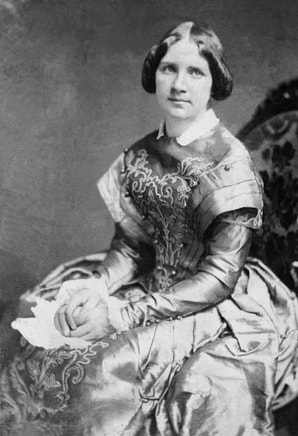|
Thumbelina, or Tommelise, was first published in 1835. An author may be inspired by many things, not all of them obvious. One theory is that the character of Thumbelina was inspired by a close friend of Hans Christian's Andersen's: Hanne Henriette Wulff, known to friends as Jette (1804 -1858). Andersen considered the Wullfs close family friends. The oldest daughter of the family, Henriette was tiny, frail, and slightly hunchbacked. She became one of Andersen's most faithful penpals, and their letters are one of the main sources of information about his life. She also helped translate some of his work to English. They seem to have had a close platonic relationship, and Andersen would portray her in his autobiography as almost his muse. The theory that she inspired Thumbelina is seen in works such as Opie's Classic Fairy Tales (1974) and Houselander's Guilt (1951). Many of Andersen's fairytales were inspired by older folklore, and there was a wealth of thumbling stories that he surely drew on for Thumbelina. Tom Thumb was famous, of course; there were also the Thumbling stories of the Brothers Grimm collection, and Danish variants such as Tommeliden or Svend Tomling. Thumbelina's opening sequence, with the lonely woman longing for a child, could be straight out of one of these tales. There were plenty of other works containing tiny people which could have inspired Andersen. As listed by Diana and Jeffrey Frank, Andersen would have been familiar with Gulliver's Travels (1726), Micromégas by Voltaire (1752), and E.T.A. Hoffmann's works "Meister Floh" (1822) and "Prinzessin Brambilla" (1820). The image of a tiny girl also appeared in Andersen's previous work and first real literary success, A Journey on Foot from Holmen's Canal to the East Point of Amager (1828). According to the Franks, there is no evidence that Thumbelina was based on Henriette. They do suggest, however, that the character of the learned but literally and metaphorically blind mole was inspired by Andersen's former teacher, Simon Meisling. Meisling was a short, overweight man who apparently did look somewhat like a mole. He repeatedly told Andersen that he would never make it as an author, calling him a stupid boy. SurLaLune also compares Thumbelina's beautiful singing voice to that of Andersen's friend, the famous singer Jenny Lind. Andersen and Lind met in 1843. In Hans Christian Andersen's Interest in Music, Gustav Hetsch and Theodore Baker assert that Lind inspired "The Nightingale," "The Angel," and "Beneath the Pillar." Another biographer, Carole Rosen, suggested in the Oxford Dictionary of National Biography that Lind inspired "The Ugly Duckling" and that her rebuffing of Andersen's affections influenced the icy-hearted Snow Queen. That last one is kind of a leap. The tale that is most likely connected to Lind is "The Nightingale." The Franks mention that right after Andersen saw her perform and visited Tivoli Gardens, which had an "Asian fantasy motif," he started the Nightingale and made note of it in his diary. He finished the story in two days (pg 139). Afterwards, as Lind grew world-famous, she was known by the nickname "The Swedish Nightingale." The Franks also say that Andersen's bleak tale "The Shadow" was aimed at a friend named Edvard Collin who had snubbed him years before (pg 16). Andersen undoubtedly drew on his experiences and the people around him for inspiration. It's entirely possible that aspects of the mole were inspired by Simon Meisling, some part of Thumbelina by Henriette Wulff, or the sweet song of the Nightingale by Jenny Lind. However, a lot of that has to remain speculation.
As for more on Henriette Wulff: she loved travelling and the sea, visiting such places as Italy, the West Indies, and the United States. After her parents' death, she lived with her brother until he died of yellow fever. She returned to Denmark, but strongly considered emigrating permanently to America, where her brother was buried. In 1858, she embarked for New York on the SS Austria. Twelve days after her departure, on September 13, there was an accident with fumigation equipment, and the ship's deck burst into flames. Passengers leaped into the sea to escape the roaring fire that engulfed the entire ship. Out of the 542 people aboard, 449 perished. Henriette was among the dead. In a poem dedicated to her, a grieving Andersen called her sister. Sources
Text copyright © Writing in Margins, All Rights Reserved
1 Comment
victory
2/10/2018 08:33:14 am
my husband and I did ttc spell once, I’m pregnant! It’s so easy and I would highly recommend others try this. We are thrilled! on facebook: oduduwa ajakaye
Reply
Leave a Reply. |
About
Researching folktales and fairies, with a focus on common tale types. Archives
July 2024
Categories
All
|
Writing in Margins

 RSS Feed
RSS Feed
